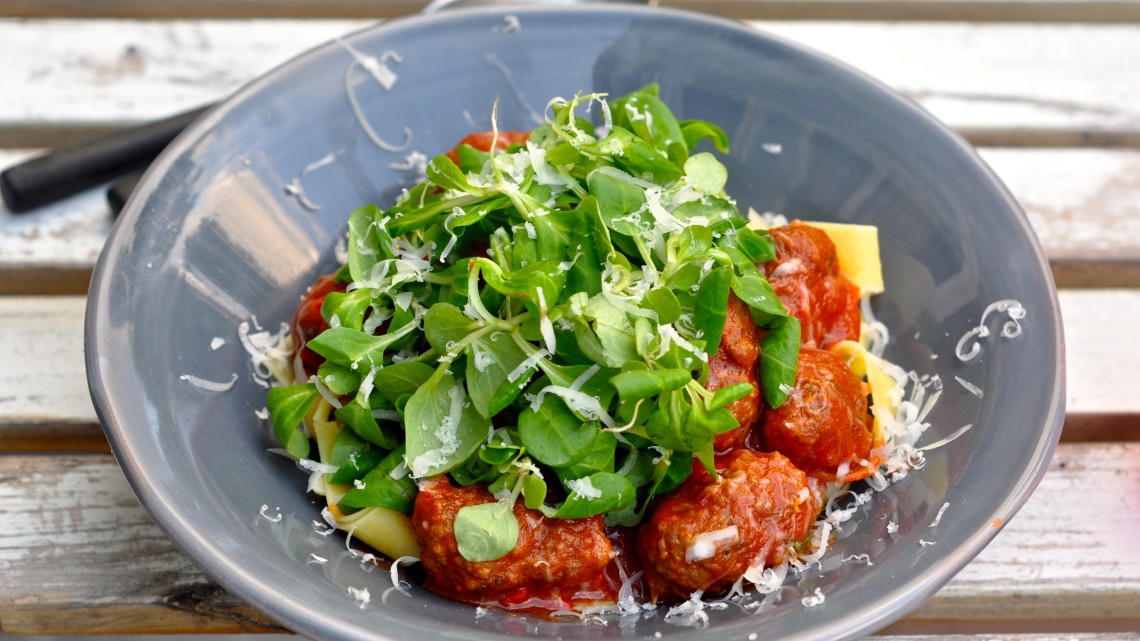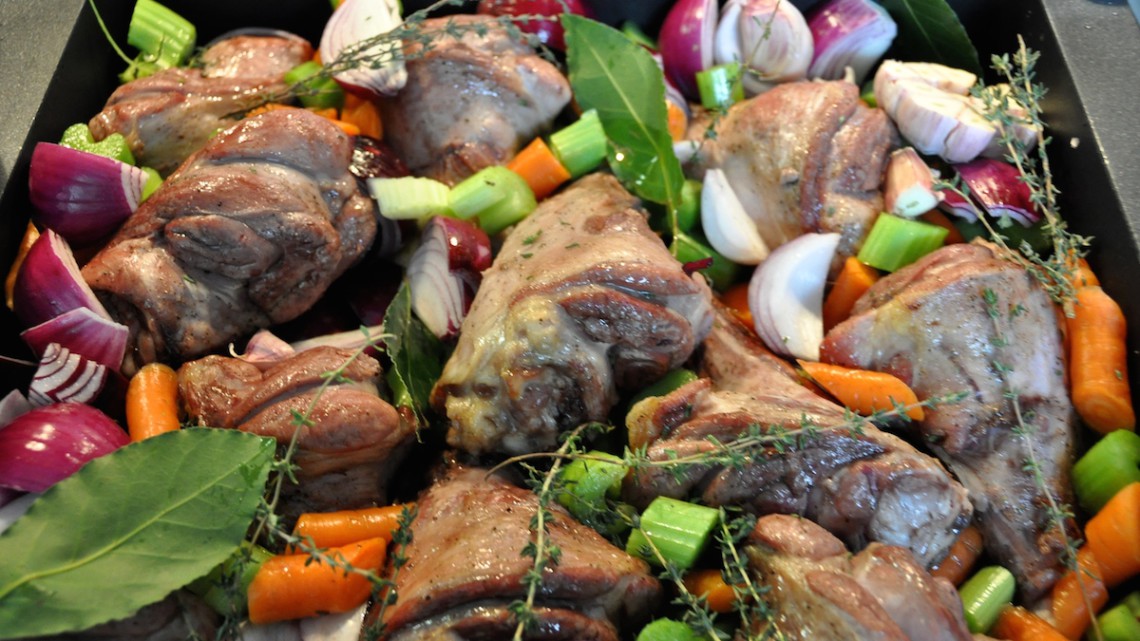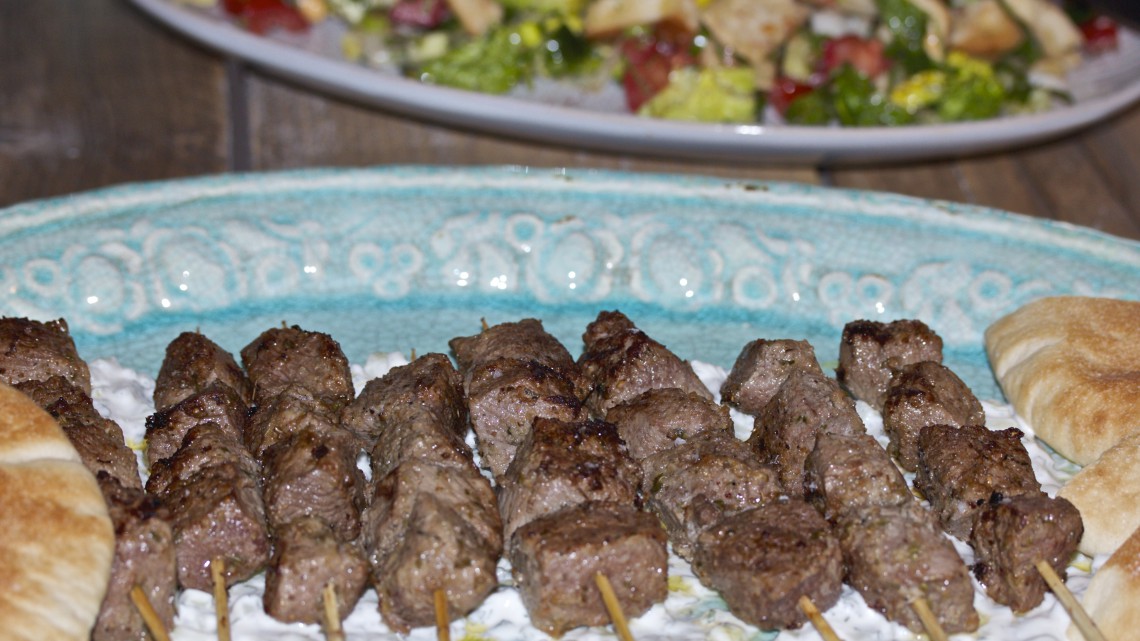Pappardelle with Italian meatballs
Serves 4
Ingredients
750 g beef mince
2 slices white bread or enough panko to bind
100 ml milk
1 sprig fresh rosemary
small bunch flat leaf parsley
100 g grated Parmesan, or more if required
2 egg yolks
salt and pepper
olive oil
1 banana shallot
2 cloves garlic
1 bottle tomato passata (750 ml)
1 red chilli pepper
1 teaspoon ground cumin
400 g pappardelle
20 g basil
Method
Place the mince in bowl and season with salt and pepper. Place the bread or panko in another bowl and pour over the milk and allow to soften for a few minutes. Finely chop the rosemary and parsley and add to the mince along with the 2 egg yolks and 40 g of the Parmesan. Squeeze the milk out of the bread, break into little pieces and add to the meat. Using your hands, knead the beef mince well. Season with salt and pepper.
Heat a frying pan with 2 tablespoons olive oil. Fry a little piece of the mince to taste if you have the seasoning correct. Add more salt and pepper, and perhaps some more Parmesan, if needed. Roll the beef mince into walnut-sized ball. Fry them, in batches, until golden on all sides. Set them aside.
Bring a pot of salted water to the boil for the pasta. Finely chop the shallot, red chilli and garlic.
Heat a frying pan over medium heat with 2 tablespoons olive oil and sweat the chopped shallot for 3 minutes. Add the garlic, chilli to taste and the ground cumin to the pan and fry for a further 1 minute.
Add the tomato passata and simmer gently for 10-15 minutes. Season with salt and pepper and set aside. Add the meat balls to the tomato sauce and keep warm.
Cook the pappardelle for about 6-7 minutes until al dente, drain off the water and divide between 4 deep bowls.
Divide the meatballs and tomato sauce over the pasta. Scatter the basil leaves and Parmesan over and serve.
Delicious served with a green salad.
We, the Amsterdam Flavours chefs, hope you enjoy this recipe as much as we do. If you have any questions on how to prepare it or just want to send us your feedback, you can reach us here Contact Amsterdam Flavours
Slow Braised Lamb Shanks
Ingredients
3 tablespoons olive oil
4 lamb shanks
4 celery sticks, roughly chopped
2 medium carrots, peeled, roughly sliced
2 red onions, unpeeled, roughly chopped
1 garlic bulb, unpeeled and halved
1 tin tomato paste
1 fresh bay leaf
5 sprigs thyme leaves
2 sprigs
300ml red wine
200ml port
500ml veal or chicken stock, or enough to cover the lamb shanks
Method
Preheat the oven to 150° C.
Heat the olive oil in a casserole and fry the lamb shanks for a few minutes, turning regularly, until browned all over. Remove from the casserole and set aside.
Add the vegetables and herbs to the casserole and fry for 5- 10 minutes.
Add the tomato paste and fry for a couple minutes to cook it out. Add the wine and port to the pot, bring to the boil and allow to reduce dor 5 minutes. Add the stock and return the lamb shanks to the casserole.
Cover the casserole with a lid and cook in the oven for 2½-3 hours, or until the lamb shanks are very tender.
To serve, remove the lamb shanks from the casserole and place onto serving plates. If the sauce is too thin, place it back on the heat and reduce until it has cooked down, intensified in flavour and has thickened slightly. Serve the lamb shanks with the sauce and vegetables poured over.
Delicious served with creamy mashed potato or soft polenta with loads of Parmesan.
We, the Amsterdam Flavours chefs, hope you enjoy this recipe as much as we do. If you have any questions on how to prepare it or just want to send us your feedback, you can reach us here Contact Amsterdam Flavours
Greek Souvlakia
Ingredients
For the souvlakia
1 kg boneless pork or lamb (eg. fillet or steaks)
1 tbsp coriander seeds
2 tsp dried oregano
150ml extra virgin olive oil
4 tbsp red wine vinegar
1 onion, grated
2 bay leaves, roughly torn
salt and freshly ground black pepper
For the tzatziki
½ cucumber, peeled and finely diced
1 tbsp white or red wine vinegar
salt and freshly ground black pepper
150g thick Greek-style yoghurt
1 clove garlic, crushed
1 tbsp fresh mint, finely chopped
Method
Cut the pork or lamb into 2cm/¾in cubes, trimming off any gristle or other unwanted fat.
Mix all the remaining souvlakia ingredients and then pour over the meat.
Turn so that all the pieces are coated, then cover and leave to marinate for at least two hours, but preferably for to 24 hours, regrigereated.
To make the tzatziki, spread the cucumber dice out in a colander or sieve, and sprinkle over the vinegar and a little salt.
Leave to drain for one hour, then pat dry with kitchen paper or a clean tea towel.
Mix with the rest of the tzatziki ingredients, then taste and adjust seasoning. Serve either lightly chilled or at room temperature. Back to the souvlakia. Soak wooden skewers in cold water for an hour or two, and then thread the meat on the skewers. Don't push the cubes right up against each other, but leave a minuscule gap between each pair, just enough space for the heat to curl round every cube, cooking it evenly.
Preheat either the barbecue or grill or an oiled griddle pan (place over a high heat for about 3-5 minutes), then cook the kebabs close to the heat, or on the griddle pan, turning and brushing occasionally with the leftover marinade, until they are crusty and brown.
Serve sizzling hot, with a wedge of lemon and the tzatziki.
Delicious served as part of a mezzo with hummus, baba ganoush, pita breads and fattoush.
We, the Amsterdam Flavours chefs, hope you enjoy this recipe as much as we do. If you have any questions on how to prepare it or just want to send us your feedback, you can reach us here Contact Amsterdam Flavours
mexican hamburger
Ingredients
2 beef hamburgers
2 ripe Haas avocado's
1 lime
1 tomato, finely diced
3 spring onions, finely sliced
pickled jalapeño chillies, to taste
small bunch coriander, finely chopped
75 g rocket
pita breads or hamburger buns, to serve
Method
Begin by making the guacamole. Halve the avocado's, remove the stones and scoop the flesh into a bowl. Mash coarsely with a fork and add the juice from the lime.
Add the finely diced tomato and sliced spring onions. Chop the jalapeño and add to the guacamole - you can make it as mild or as spicy as you like. Season with salt and pepper. Lastly add the chopped coriander. Place the avocado stones into the guacamole and cover with plastic wrap. This helps prevent the avocado from discolouring.
Heat a griddle pan over medium heat. Drizzle the hamburgers with a little olive oil and grill until cooked through, about 10-12 minutes. The cooking time depends on the size your hamburgers. If they happen to be quite thick, a good tip is to flatten them with the palm of your hand before you cook them.
Remove the burgers from the pan, wipe out some of the excess fat with paper towel. Slice open the pita or hamburger buns and toast lightly.
Dress the rocket with a drizzle of olive oil, salt and pepper and discard the avocado stones from the guacamole. Fill each pita or bun with a handful of rocket, top with the burgers and spoon a generous amount of guacamole on top.
This is one of our favourite recipes!
We, the Amsterdam Flavours chefs, hope you enjoy this recipe as much as we do. If you have any questions on how to prepare it or just want to send us your feedback, you can reach us here Contact Amsterdam Flavours
Roasted Pork
Serves 8
Ingredients
3 kg pork loin, bone in
sea salt
1 tablespoon freshly chopped rosemary
2 teaspoons fennel seeds
5 cloves garlic
8 tablespoons balsamic vinegar
4 bay leaves
2 tablespoons olive oil
some pork bones, chopped (ask your butcher for this)
4 sticks celery, roughly chopped
1 carrot, roughly chopped
2 onions, roughly chopped
Method
Using a sharp knife or stanley blade, score the skin of the pork in a criss-cross fashion, If you have a good butcher, you can ask him to do this for you. Rub some sea salt and half the chopped rosemary into the scored skin, pushing as much as you can into the cuts. In a pestle and mortar, pound the fennel seeds, garlic cloves and remaining rosemary into a puree and rub onto the meat. If you rub it on to the skin, it will burn during the cooking. Place the pork loin into a large roasting tray with the balsamic vinegar, bay leaves and olive oil and allow to marinate for at least and hour.
In the meantime, preheat the oven to its highest setting and brown the pork bones. Rub a little more salt into the pork skin to ensure it crisps up in the oven. Lay the pork directly on the oven rack in the top part of the oven. Add the browned bones and vegetables to the balsamic marinade, add 600 ml water to the roasting dish and place the tray in the oven, directly under the pork. As the pork roasts, all the juices will drip down into the roasting dish, which will be used later to make the sauce.
The pork will take about an hour to cook. After about 20 minutes, reduce the oven temperature to 220° C. When the pork is done, remove from the oven and lay on a piece of aluminium foil, to catch all the juices. Allow the meat to rest for at least 15 minutes.
While the pork is resting, finish the sauce. Place the bones, the liquid and the vegetables in a pot. Add a little water to the roasting tray, set over a medium heat on the stove. Scrape all the sticky goodness off the bottom and bring to the boil. Add to the pot with all the other ingredients. Bring this to the boil, skimming off any impurities which may rise to the surface. Pour through a sieve, discarding the bones and vegetables. Pour the sauce back into the pot, boil to reduce slightly and add salt of necessary. Serve the pork, sliced, with the sauce, some roast potatoes and green seasonal veg.
We, the Amsterdam Flavours chefs, hope you enjoy this recipe as much as we do. If you have any questions on how to prepare it or just want to send us your feedback, you can reach us here Contact Amsterdam Flavours





